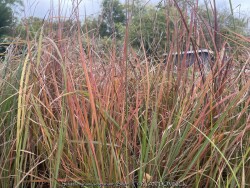

Little bluestem (Schizachyrium scoparium) is a prominent prairie grass usually found in the short to medium grass prairies of Kansas and most common in the midwest and Great Plains. It also occurs sporadically throughout most of the United States in open areas where trees cannot grow. The spring and summer foliage is mint green to blue green. Depending on the variety, they gradually turn a reddish purple color in late summer progressing to deeper reddish purple, red, or orange by fall. At this time when the seed heads have extended, it is at its prettiest. As cold weather sets in and freezes occur, dried foliage turns a pinkish orange with tan and red shades again depending on the variety. Winter color is persistent and lasts until spring cut back in March. Little bluestem is very tolerant of different soils but prefers dry, sandy, loam, or clay soils with plenty of full sun. If planted in rich soil or given too much water, plants tend to grow too tall and flop by late summer. However, there are now improved cultivars that resist flopping. Good air circulation and some wind is needed to avoid rust diseases in humid areas. Sometimes if planted too shallow or if mulched too thickly, plants can heave and die in the winter. In the landscape, little bluestem looks best when planted in medium to large groups giving the look of a miniature prairie. It also combines very well with many other plants that have different textures and colors. Generally if given the proper placement and growing conditions, little bluestem will last indefinitely. Little bluestem as one of the four major grasses (along with Big bluestem, Indiangrass, and Switchgrass) covering millions of acres and Kansas including the Flint Hills. Where and when conditions are safe, it can be burned in late winter or early spring in a prairie or meadow before new growth appears. Many cultivars have been released improving foliage color and flop resistance. Blaze Little Bluestem Grass (Schizachyrium scoparium 'Blaze') is a cultivar originally selected by agronomists in Nebraska as a high yielding pasture grass. Blaze is also used ornamentally for its vivid red fall foliage. In winter it remains a standout as the leaves fade to deep pink and is considered one of the best for winter color.


Little bluestem (Schizachyrium scoparium) is a prominent prairie grass usually found in the short to medium grass prairies of Kansas and most common in the midwest and Great Plains. It also occurs sporadically throughout most of the United States in open areas where trees cannot grow. The spring and summer foliage is mint green to blue green. Depending on the variety, they gradually turn a reddish purple color in late summer progressing to deeper reddish purple, red, or orange by fall. At this time when the seed heads have extended, it is at its prettiest. As cold weather sets in and freezes occur, dried foliage turns a pinkish orange with tan and red shades again depending on the variety. Winter color is persistent and lasts until spring cut back in March. Little bluestem is very tolerant of different soils but prefers dry, sandy, loam, or clay soils with plenty of full sun. If planted in rich soil or given too much water, plants tend to grow too tall and flop by late summer. However, there are now improved cultivars that resist flopping. Good air circulation and some wind is needed to avoid rust diseases in humid areas. Sometimes if planted too shallow or if mulched too thickly, plants can heave and die in the winter. In the landscape, little bluestem looks best when planted in medium to large groups giving the look of a miniature prairie. It also combines very well with many other plants that have different textures and colors. Generally if given the proper placement and growing conditions, little bluestem will last indefinitely. Little bluestem as one of the four major grasses (along with Big bluestem, Indiangrass, and Switchgrass) covering millions of acres and Kansas including the Flint Hills. Where and when conditions are safe, it can be burned in late winter or early spring in a prairie or meadow before new growth appears. Many cultivars have been released improving foliage color and flop resistance. Standing Ovation Little Bluestem Grass (Schizachyrium scoparium 'Standing Ovation') is characterized by its wide leaf blades and its blue foliage with red tips throughout the growing season that change to red and maroon in fall with rich purple coloring at the base. It is upright and has a rigid habit that is retained without lodging when plants are grown in rich soils or during container production. Standing Ovation is a North Creek Nurseries Inc. introduction from Pennsylvania.
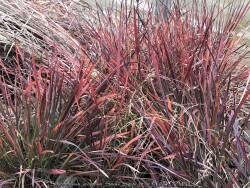

Little bluestem (Schizachyrium scoparium) is a prominent prairie grass usually found in the short to medium grass prairies of Kansas and most common in the midwest and Great Plains. It also occurs sporadically throughout most of the United States in open areas where trees cannot grow. The spring and summer foliage is mint green to blue green. Depending on the variety, they gradually turn a reddish purple color in late summer progressing to deeper reddish purple, red, or orange by fall. At this time when the seed heads have extended, it is at its prettiest. As cold weather sets in and freezes occur, dried foliage turns a pinkish orange with tan and red shades again depending on the variety. Winter color is persistent and lasts until spring cut back in March. Little bluestem is very tolerant of different soils but prefers dry, sandy, loam, or clay soils with plenty of full sun. If planted in rich soil or given too much water, plants tend to grow too tall and flop by late summer. However, there are now improved cultivars that resist flopping. Good air circulation and some wind is needed to avoid rust diseases in humid areas. Sometimes if planted too shallow or if mulched too thickly, plants can heave and die in the winter. In the landscape, little bluestem looks best when planted in medium to large groups giving the look of a miniature prairie. It also combines very well with many other plants that have different textures and colors. Generally if given the proper placement and growing conditions, little bluestem will last indefinitely. Little bluestem as one of the four major grasses (along with Big bluestem, Indiangrass, and Switchgrass) covering millions of acres and Kansas including the Flint Hills. Where and when conditions are safe, it can be burned in late winter or early spring in a prairie or meadow before new growth appears. Many cultivars have been released improving foliage color and flop resistance. Smoke Signal Little Bluestem Grass (Schizachyrium scoparium 'Smoke Signal') has a beautifully refined habit and puts forth a strong show of color in late summer and fall. The glaucous blue-green foliage begins to take on scarlet red tones in late summer, turning a deeper red-purple through the fall. Tiny, tan seed heads appear in early fall on the top half of the stems. An improvement over older cultivars, this grass maintains its strictly upright habit through fall. Smoke Signal is a Walters Gardens Inc. introduction.
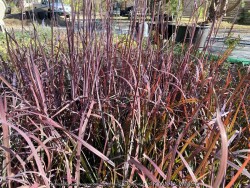

Little bluestem (Schizachyrium scoparium) is a prominent prairie grass usually found in the short to medium grass prairies of Kansas and most common in the midwest and Great Plains. It also occurs sporadically throughout most of the United States in open areas where trees cannot grow. The spring and summer foliage is mint green to blue green. Depending on the variety, they gradually turn a reddish purple color in late summer progressing to deeper reddish purple, red, or orange by fall. At this time when the seed heads have extended, it is at its prettiest. As cold weather sets in and freezes occur, dried foliage turns a pinkish orange with tan and red shades again depending on the variety. Winter color is persistent and lasts until spring cut back in March. Little bluestem is very tolerant of different soils but prefers dry, sandy, loam, or clay soils with plenty of full sun. If planted in rich soil or given too much water, plants tend to grow too tall and flop by late summer. However, there are now improved cultivars that resist flopping. Good air circulation and some wind is needed to avoid rust diseases in humid areas. Sometimes if planted too shallow or if mulched too thickly, plants can heave and die in the winter. In the landscape, little bluestem looks best when planted in medium to large groups giving the look of a miniature prairie. It also combines very well with many other plants that have different textures and colors. Generally if given the proper placement and growing conditions, little bluestem will last indefinitely. Little bluestem as one of the four major grasses (along with Big bluestem, Indiangrass, and Switchgrass) covering millions of acres and Kansas including the Flint Hills. Where and when conditions are safe, it can be burned in late winter or early spring in a prairie or meadow before new growth appears. Many cultivars have been released improving foliage color and flop resistance. Standing Ovation Little Bluestem Grass (Schizachyrium scoparium 'Standing Ovation') is characterized by its wide leaf blades and its blue foliage with red tips throughout the growing season that change to red and maroon in fall with rich purple coloring at the base. It is upright and has a rigid habit that is retained without lodging when plants are grown in rich soils or during container production. Standing Ovation is a North Creek Nurseries Inc. introduction from Pennsylvania.
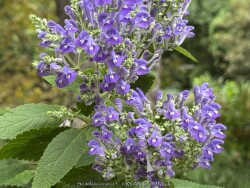

***Description for this perennial available with future update!*** Scutellaria incana is also known as Hoary Skullcap / Downy Skullcap.
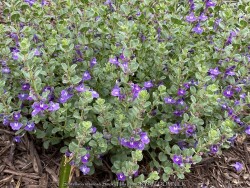

***Description for this perennial available with future update!***Smoky Hills Skullcap / Native Scutellaria, is also known as Scutellaria resinosa 'Smoky Hills'
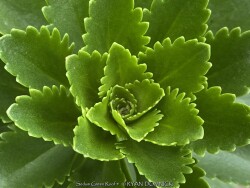

***Description for this perennial available with future update!*** Sedum 'Green Roof' is also known as Green Roof Sedum.
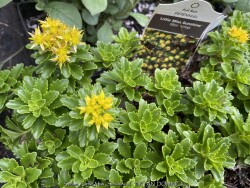

***Description for this perennial available with future update!***Little Miss Sunshine Sedum, is also known as Sedum 'Little Miss Sunshine'
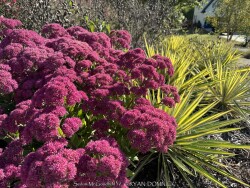

***Description for this perennial available with future update!***Mr.Goodbud / Carl Sedum, is also known as Sedum 'Mr.Goodbud / Carl'
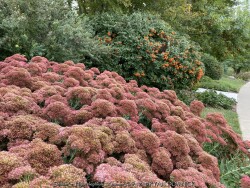

***Description for this perennial available with future update!***Autumn Fire Sedum, is also known as Sedum / Hylotelephium 'Autumn Fire'
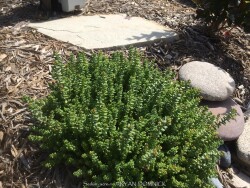

***Description for this perennial available with future update!***Mossy Stonecrop / Sedum, is also known as Sedum acre
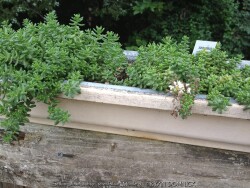

***Description for this perennial available with future update!***White Creeping Sedum, is also known as Sedum album


***Description for this perennial available with future update!***Blue Corsican Sedum, is also known as Sedum dasyphyllum 'Major'
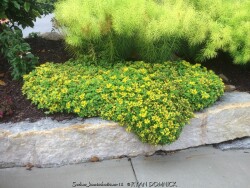

Kamtschaticum Sedum (Sedum kamtschaticum) is known for its compact mats of bright green foliage and yellow-gold flowers in the spring. Fall color turns a beautiful firey orange-red before going dormant. Kamtschaticum Sedum is native to northern China and along the Pacific coast of Siberia including the Kamchatka Peninsula with a similar climate of cold winters and hot summers. Bright green growth emerges early in the spring and spread slowly, rooting a little bit as it spreads but not aggressively. Growth is dense enough to resist most weeds. Kamtschaticum Sedum is useful as a small scale groundcover, rock garden plant, retaining wall plant, or even dry shade gardens. This tough sedum will grow in full sun to full shade in just about any soil except for wet poorly drained ones. Of all of the sedums, this is probably the most resistant to any kind of problems including root rot. I have witnessed clumps surviving and thriving for 20-30 years or more. There is really almost no maintenance with this sedum but you may choose to weed eat it in the winter for a more tidy appearance. The only slight problem is that when grown with too much water, The crown opens up as it flops over and looks slightly untidy. The flowering period is also pretty short. Considered one of the best plants for solving your most difficult dry-shade landscape challenges.
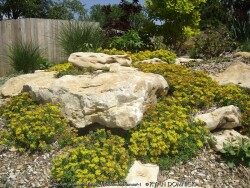

Kamtschaticum Sedum (Sedum kamtschaticum) is known for its compact mats of bright green foliage and yellow-gold flowers in the spring. Fall color turns a beautiful firey orange-red before going dormant. Kamtschaticum Sedum is native to northern China and along the Pacific coast of Siberia including the Kamchatka Peninsula with a similar climate of cold winters and hot summers. Bright green growth emerges early in the spring and spread slowly, rooting a little bit as it spreads but not aggressively. Growth is dense enough to resist most weeds. Kamtschaticum Sedum is useful as a small scale groundcover, rock garden plant, retaining wall plant, or even dry shade gardens. This tough sedum will grow in full sun to full shade in just about any soil except for wet poorly drained ones. Of all of the sedums, this is probably the most resistant to any kind of problems including root rot. I have witnessed clumps surviving and thriving for 20-30 years or more. There is really almost no maintenance with this sedum but you may choose to weed eat it in the winter for a more tidy appearance. The only slight problem is that when grown with too much water, The crown opens up as it flops over and looks slightly untidy. The flowering period is also pretty short. Considered one of the best plants for solving your most difficult dry-shade landscape challenges. Tooth-Leaf Kamtschaticum Sedum (Sedum kamtschaticum var. middendorffianum) is a shorter more drought tolerant variety with tooth-like jagged edges. The clump does not open up and flop. This variety is also more tolerant of full hot sun and shallow soils also making it an ideal roof-garden plant.
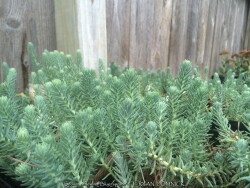

***Description for this perennial available with future update!***Blue Spruce Sedum, is also known as Sedum reflexum
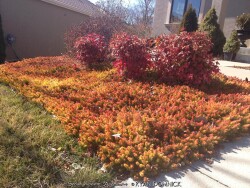

***Description for this perennial available with future update!***Angelina Gold & Orange Sedum, is also known as Sedum rupestre 'Angelina'
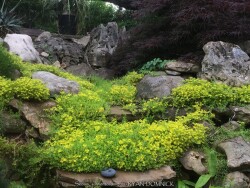

***Description for this perennial available with future update!*** Sedum sarmentosum is also known as Gold Moss Dry Shade Sedum>>>>> This plant can also be in a water garden stream as long as the water is constantly moving: stagnant water is not tolerated. Considered one of the best plants for solving your most difficult dry-shade landscape challenges.
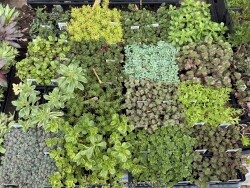

***Description for this perennial available with future update!***Sedum (Mixed Groundcover flats), is also known as Sedum sp.


***Description for this perennial available with future update!***Sedum (Mixed Varieties) (large), is also known as Sedum sp.
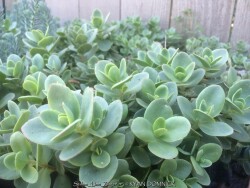

***Description for this perennial available with future update!***Sedum (Mixed Varieties) (small), is also known as Sedum sp.
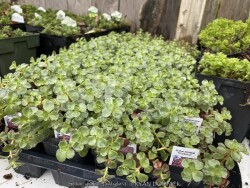

***Description for this perennial available with future update!***Improved Dragon's Blood Sedum, is also known as Sedum spurium 'Fuldaglut' / 'Fulda Glow'


Kamtschaticum Sedum (Sedum kamtschaticum) is known for its compact mats of bright green foliage and yellow-gold flowers in the spring. Fall color turns a beautiful firey orange-red before going dormant. Kamtschaticum Sedum is native to northern China and along the Pacific coast of Siberia including the Kamchatka Peninsula with a similar climate of cold winters and hot summers. Bright green growth emerges early in the spring and spread slowly, rooting a little bit as it spreads but not aggressively. Growth is dense enough to resist most weeds. Kamtschaticum Sedum is useful as a small scale groundcover, rock garden plant, retaining wall plant, or even dry shade gardens. This tough sedum will grow in full sun to full shade in just about any soil except for wet poorly drained ones. Of all of the sedums, this is probably the most resistant to any kind of problems including root rot. I have witnessed clumps surviving and thriving for 20-30 years or more. There is really almost no maintenance with this sedum but you may choose to weed eat it in the winter for a more tidy appearance. The only slight problem is that when grown with too much water, The crown opens up as it flops over and looks slightly untidy. The flowering period is also pretty short. Considered one of the best plants for solving your most difficult dry-shade landscape challenges. Big-Leaf Kamtschaticum Sedum (Sedum takesimensis / kamtschaticum) is taller with larger leaves and larger flowers, about double that of the species.
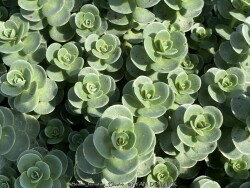

***Description for this perennial available with future update!***Native White Sedum, is also known as Sedum ternatum
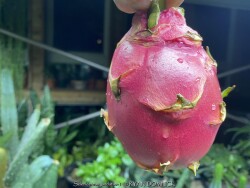

Dragon Fruit cacti are grown for delicious nutritious fruits. This tropical jungle cactus has a few requirements in order to thrive but nothing too hard. Give them bright indirect light and water only when dry. They are usually grown as a house plant in Kansas but can be moved outside if kept in part shade to shade. Leaves can sunburn but morning or filtered sun is ok! Dragon Fruit, like all true cacti, originates in the Americas. It is a sprawling or vining, terrestrial or epiphytic cactus. They climb trees and walls by use of aerial roots and can reach a height of 30 feet in the wild. Protect from temperatures below 45 degrees F and move into a bright window over the winter with no watering. As a winter house plant, it will look presentable all winter long with just a few waterings. Repotting may or may not be needed depending on how large you want the plant to grow; plants can continue to grow in the same pot for years. If repotting, make sure to use a sharp draining highly organic cactus mix with plenty of sand and perlite. This is relatively uncommon plant never seen at the big box stores and will command a higher price than most other houseplants. Plants are usually grown in hanging baskets and take up alot of space. Fruit may or may not occur in this climate; I have seen flowering but not fruit.
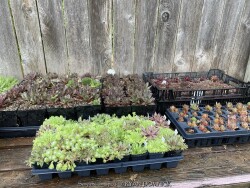

These tiny perennial succulents (Sempervivum sp.) produce various colored mats of foliage rosettes. In favorable conditions they can spread rapidly by offsets; several species are valued in cultivation as groundcover for dry, sunny locations. Hen & Chicks are native to alpine mountainous areas in native to southern Europe and northern Africa. Grow this small native gem in a rock garden, in cracks between rocks, or on top of or in a retaining wall. You may also grow in flat areas like in between stepping stones provided you used a gravelly or sandy base for the stones. It will not tolerate rich moist soils as other plants or weeds will shade it out. Crown rot can occur during lengthy hot humid summer rainy periods. Hen & Chicks do not thrive indoors; aphids and spider mites seem to find them after a few months but overwintering indoors in a cool environment may work. Plants with plenty of time to acclimate will thrive in full sun but be careful not to rush it or sunburning will occur. Generally if moving outside for the summer, allow 2-3 weeks of part shade or morning sun before placing in full sun. If grown in pots and kept on the dry side, you may leave out all winter allowing to freeze solid; plants will go dormant and resume growth in the spring. This is more successful than overwintering inside. Great low maintenance cold hardy succulent.
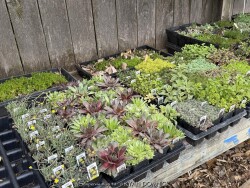

These tiny perennial succulents (Sempervivum sp.) produce various colored mats of foliage rosettes. In favorable conditions they can spread rapidly by offsets; several species are valued in cultivation as groundcover for dry, sunny locations. Hen & Chicks are native to alpine mountainous areas in native to southern Europe and northern Africa. Grow this small native gem in a rock garden, in cracks between rocks, or on top of or in a retaining wall. You may also grow in flat areas like in between stepping stones provided you used a gravelly or sandy base for the stones. It will not tolerate rich moist soils as other plants or weeds will shade it out. Crown rot can occur during lengthy hot humid summer rainy periods. Hen & Chicks do not thrive indoors; aphids and spider mites seem to find them after a few months but overwintering indoors in a cool environment may work. Plants with plenty of time to acclimate will thrive in full sun but be careful not to rush it or sunburning will occur. Generally if moving outside for the summer, allow 2-3 weeks of part shade or morning sun before placing in full sun. If grown in pots and kept on the dry side, you may leave out all winter allowing to freeze solid; plants will go dormant and resume growth in the spring. This is more successful than overwintering inside. Great low maintenance cold hardy succulent.
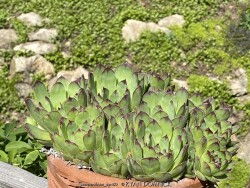

These tiny perennial succulents (Sempervivum sp.) produce various colored mats of foliage rosettes. In favorable conditions they can spread rapidly by offsets; several species are valued in cultivation as groundcover for dry, sunny locations. Hen & Chicks are native to alpine mountainous areas in native to southern Europe and northern Africa. Grow this small native gem in a rock garden, in cracks between rocks, or on top of or in a retaining wall. You may also grow in flat areas like in between stepping stones provided you used a gravelly or sandy base for the stones. It will not tolerate rich moist soils as other plants or weeds will shade it out. Crown rot can occur during lengthy hot humid summer rainy periods. Hen & Chicks do not thrive indoors; aphids and spider mites seem to find them after a few months but overwintering indoors in a cool environment may work. Plants with plenty of time to acclimate will thrive in full sun but be careful not to rush it or sunburning will occur. Generally if moving outside for the summer, allow 2-3 weeks of part shade or morning sun before placing in full sun. If grown in pots and kept on the dry side, you may leave out all winter allowing to freeze solid; plants will go dormant and resume growth in the spring. This is more successful than overwintering inside. Great low maintenance cold hardy succulent. Red-tip Green Hen & Chicks are among the largest, most reliable, and fastest growing.
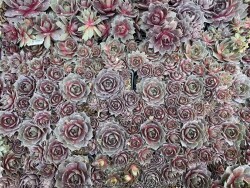

These tiny perennial succulents (Sempervivum sp.) produce various colored mats of foliage rosettes. In favorable conditions they can spread rapidly by offsets; several species are valued in cultivation as groundcover for dry, sunny locations. Hen & Chicks are native to alpine mountainous areas in native to southern Europe and northern Africa. Grow this small native gem in a rock garden, in cracks between rocks, or on top of or in a retaining wall. You may also grow in flat areas like in between stepping stones provided you used a gravelly or sandy base for the stones. It will not tolerate rich moist soils as other plants or weeds will shade it out. Crown rot can occur during lengthy hot humid summer rainy periods. Hen & Chicks do not thrive indoors; aphids and spider mites seem to find them after a few months but overwintering indoors in a cool environment may work. Plants with plenty of time to acclimate will thrive in full sun but be careful not to rush it or sunburning will occur. Generally if moving outside for the summer, allow 2-3 weeks of part shade or morning sun before placing in full sun. If grown in pots and kept on the dry side, you may leave out all winter allowing to freeze solid; plants will go dormant and resume growth in the spring. This is more successful than overwintering inside. Great low maintenance cold hardy succulent. Burgundy Hen & Chicks (Sempervivum tectorum) are brightly colored with new growth emerging bright purple darkening with age.


String of Bananas (Senecio / Curio radicans) grows long green stems with interesting banana-shaped alternating leaves. They are usually grown as a patio or house plant in Kansas. String of Bananas also grow well in hanging baskets as a durable, succulent plant able to survive drying out, heat and dry air like few others! To play is safe, potted plants are best moved in before night temperatures get below 45 degrees F. It is important to avoid the combination of wet and cold. Before extreme cold occurs, move to a bright interior window over the winter with no watering and keep above freezing. As a winter house plant, it will look presentable all winter long with just no waterings. As a permanent house plant, provide bright light and allow the soil to dry between waterings for many years of carefree enjoyment. Generally if moving outside for the summer, allow 1-2 weeks of part shade or morning sun before placing in full sun. Plants with time to acclimate will thrive in full sun but be careful not to rush it or sunburning will occur. Full hot sun over 100 degrees F can also burn the top of the hanging basket killing the stems where they touch the pot rim and dirt. Avoid this by moving into part-shade during the hottest part of the summer. Potted plants are very low maintenance. I have never seen any insect problems on this plant. String of Bananas is the toughest, most trouble-free of the Senecio cascaders.
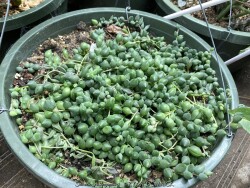

String of Pearls (Senecio / Curio rowleyanus) grows long green stems with interesting sphere-shaped alternating leaves. They are usually grown as a patio or house plant in Kansas. String of Pearls also grow well in hanging baskets as a durable, succulent plant able to survive drying out, heat and dry air like few others! To play is safe, potted plants are best moved in before night temperatures get below 45 degrees F. It is important to avoid the combination of wet and cold. Before extreme cold occurs, move to a bright interior window over the winter with no watering and keep above freezing. As a winter house plant, it will look presentable all winter long with just no waterings. As a permanent house plant, provide bright light and allow the soil to dry between waterings for many years of carefree enjoyment. Generally if moving outside for the summer, allow 1-2 weeks of part shade or morning sun before placing in full sun. Plants with time to acclimate will thrive in full sun but be careful not to rush it or sunburning will occur. Full hot sun over 100 degrees F can also burn the top of the hanging basket killing the stems where they touch the pot rim and dirt. Avoid this by moving into part-shade during the hottest part of the summer. Potted plants are very low maintenance. I have never seen any insect problems on this plant.
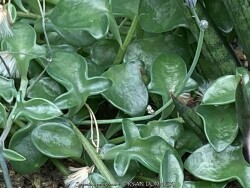

String of Dolphins (Senecio / Curio x peregrinum) grows long green stems with interesting dolphin-shaped alternating leaves. They are usually grown as a patio or house plant in Kansas. String of Dolphins also grow well in hanging baskets as a durable, succulent plant able to survive drying out, heat and dry air like few others! To play is safe, potted plants are best moved in before night temperatures get below 45 degrees F. It is important to avoid the combination of wet and cold. Before extreme cold occurs, move to a bright interior window over the winter with no watering and keep above freezing. As a winter house plant, it will look presentable all winter long with just no waterings. As a permanent house plant, provide bright light and allow the soil to dry between waterings for many years of carefree enjoyment. Generally if moving outside for the summer, allow 1-2 weeks of part shade or morning sun before placing in full sun. Plants with time to acclimate will thrive in full sun but be careful not to rush it or sunburning will occur. Full hot sun over 100 degrees F can also burn the top of the hanging basket killing the stems where they touch the pot rim and dirt. Avoid this by moving into part-shade during the hottest part of the summer. Potted plants are very low maintenance. I have never seen any insect problems on this plant.
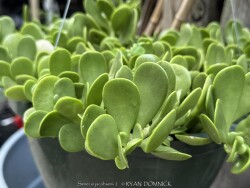

***Description for this plant available with future update!*** Senecio jacobsenii is also known as Trailing Jade Vine (Tropical).
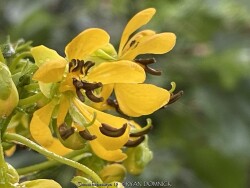

***Description for this perennial available with future update!*** Senna marilandica / hebecarpa is also known as Wild Senna.
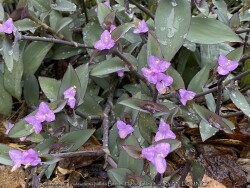

Purple Heart (Setcreasea / Tradescantia pallida 'Purple Heart') is the most versatile plant in out library: it can be an annual, perennial, patio plant, house plant, or hanging basket in wet or dry soil in full shade or full sun. It can handle growing in standing water or bone dry. In dry soils, it shows no drought stress, continuing to grow with a deeper purple shade. In moist soils, this plant will grow rapidly. In shade, the foliage becomes more greenish but still looks attractive. In Kansas, it is usually grown as an annual. Brilliant purple leaves contrast small pink flowers in the summer! Plants will quickly fill an annual bed with bright purple color all summer til first hard freeze. In the ground, it is possible to overwinter these in the ground in Kansas by placing a giant 6-8" mound of mulch over deeply planted rhizomes. Not sure what's easier, buying and moving that much mulch or replanting in spring?: you decide. If growing as a potted plant and trying to overwinter, allowing the foliage to frost is ok, it will not kill the root system. However, do not allow the pot with rootball to freeze solid or go below 20 degrees for more than a few hours. Allow to go dormant as needed with little care, just cut off dead foliage and place back out in April or May with a time-release fertilizer. Many plants will die back slowly and remain attractive inside for most of the winter. Purple heart plants have no insect, disease or animal pests. Botanical name has recently changed from Setcreasea to Tradescantia. This 'Giant' form (Setcreasea / Tradescantia pallida 'Kartuz Giant'), originally purchased at Bustani Plant Farm in Stillwater Oklahoma, has much larger tropical-like foliage. This form survived -16 degrees F and a week of single digit highs in February, 2021 with 3-4" of mulch.


Purple Heart (Setcreasea / Tradescantia pallida 'Purple Heart') is the most versatile plant in out library: it can be an annual, perennial, patio plant, house plant, or hanging basket in wet or dry soil in full shade or full sun. It can handle growing in standing water or bone dry. In dry soils, it shows no drought stress, continuing to grow with a deeper purple shade. In moist soils, this plant will grow rapidly. In shade, the foliage becomes more greenish but still looks attractive. In Kansas, it is usually grown as an annual. Brilliant purple leaves contrast small pink flowers in the summer! Plants will quickly fill an annual bed with bright purple color all summer til first hard freeze. In the ground, it is possible to overwinter these in the ground in Kansas by placing a giant 6-8" mound of mulch over deeply planted rhizomes. Not sure what's easier, buying and moving that much mulch or replanting in spring?: you decide. If growing as a potted plant and trying to overwinter, allowing the foliage to frost is ok, it will not kill the root system. However, do not allow the pot with rootball to freeze solid or go below 20 degrees for more than a few hours. Allow to go dormant as needed with little care, just cut off dead foliage and place back out in April or May with a time-release fertilizer. Many plants will die back slowly and remain attractive inside for most of the winter. Purple heart plants have no insect, disease or animal pests. Botanical name has recently changed from Setcreasea to Tradescantia. This 'Giant' form (Setcreasea / Tradescantia pallida 'Kartuz Giant'), originally purchased at Bustani Plant Farm in Stillwater Oklahoma, has much larger tropical-like foliage. This form survived -16 degrees F and a week of single digit highs in February, 2021 with 3-4" of mulch.
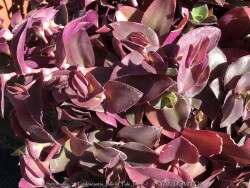

Purple Heart (Setcreasea / Tradescantia pallida 'Purple Heart') is the most versatile plant in out library: it can be an annual, perennial, patio plant, house plant, or hanging basket in wet or dry soil in full shade or full sun. It can handle growing in standing water or bone dry. In dry soils, it shows no drought stress, continuing to grow with a deeper purple shade. In moist soils, this plant will grow rapidly. In shade, the foliage becomes more greenish but still looks attractive. In Kansas, it is usually grown as an annual. Brilliant purple leaves contrast small pink flowers in the summer! Plants will quickly fill an annual bed with bright purple color all summer til first hard freeze. In the ground, it is possible to overwinter these in the ground in Kansas by placing a giant 6-12" mound of mulch over deeply planted rhizomes. Not sure what's easier, buying and moving that much mulch or replanting in spring?: you decide. If growing as a potted plant and trying to overwinter, allowing the foliage to frost is ok, it will not kill the root system. However, do not allow the pot with rootball to freeze solid or go below 20 degrees for more than a few hours. Allow to go dormant as needed with little care, just cut off dead foliage and place back out in April or May with a time-release fertilizer. Many plants will die back slowly and remain attractive inside for most of the winter. Purple heart plants have no insect, disease or animal pests. Botanical name has recently changed from Setcreasea to Tradescantia. The 'Pale Puma' form (Setcreasea / Tradescantia pallida 'Pale Puma') has much more compact foliage and dense root system. When grown in a hanging basket, the foliage creates a purple globe effect. We have not tested this variety for outdoor hardiness in our Lawrence, KS (zone 6a) garden yet (2022).
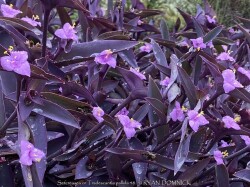

Purple Heart (Setcreasea / Tradescantia pallida 'Purple Heart') is the most versatile plant in out library: it can be an annual, perennial, patio plant, house plant, or hanging basket in wet or dry soil in full shade or full sun. It can handle growing in standing water or bone dry. In dry soils, it shows no drought stress, continuing to grow with a deeper purple shade. In moist soils, this plant will grow rapidly. In shade, the foliage becomes more greenish but still looks attractive. In Kansas, it is usually grown as an annual. Brilliant purple leaves contrast small pink flowers in the summer! Plants will quickly fill an annual bed with bright purple color all summer til first hard freeze. In the ground, it is possible to overwinter these in the ground in Kansas by placing a 6-8" mound of mulch over deeply planted rhizomes. Not sure what's easier, buying and moving that much mulch or replanting in spring?: you decide. If growing as a potted plant and trying to overwinter, allowing the foliage to frost is ok, it will not kill the root system. However, do not allow the pot with rootball to freeze solid or go below 20 degrees for more than a few hours. Allow to go dormant as needed with little care, just cut off dead foliage and place back out in April or May with a time-release fertilizer. Many plants will die back slowly and remain attractive inside for most of the winter. Purple heart plants have no insect, disease or animal pests. Botanical name has recently changed from Setcreasea to Tradescantia. A variegated form is also available. This plant survived in our Lawrence, KS display garden down to -16 degrees F and a week of single digit highs in February, 2021 with mulch.
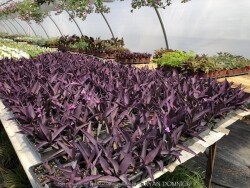

Purple Heart (Setcreasea / Tradescantia pallida 'Purple Heart') is the most versatile plant in out library: it can be an annual, perennial, patio plant, house plant, or hanging basket in wet or dry soil in full shade or full sun. It can handle growing in standing water or bone dry. In dry soils, it shows no drought stress, continuing to grow with a deeper purple shade. In moist soils, this plant will grow rapidly. In shade, the foliage becomes more greenish but still looks attractive. In Kansas, it is usually grown as an annual. Brilliant purple leaves contrast small pink flowers in the summer! Plants will quickly fill an annual bed with bright purple color all summer til first hard freeze. In the ground, it is possible to overwinter these in the ground in Kansas by placing a 6-8" mound of mulch over deeply planted rhizomes. Not sure what's easier, buying and moving that much mulch or replanting in spring?: you decide. If growing as a potted plant and trying to overwinter, allowing the foliage to frost is ok, it will not kill the root system. However, do not allow the pot with rootball to freeze solid or go below 20 degrees for more than a few hours. Allow to go dormant as needed with little care, just cut off dead foliage and place back out in April or May with a time-release fertilizer. Many plants will die back slowly and remain attractive inside for most of the winter. Purple heart plants have no insect, disease or animal pests. Botanical name has recently changed from Setcreasea to Tradescantia. A variegated form is also available. This plant survived in our Lawrence, KS display garden down to -16 degrees F and a week of single digit highs in February, 2021 with mulch.
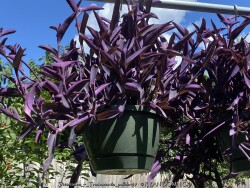

Purple Heart (Setcreasea / Tradescantia pallida 'Purple Heart') is the most versatile plant in out library: it can be an annual, perennial, patio plant, house plant, or hanging basket in wet or dry soil in full shade or full sun. It can handle growing in standing water or bone dry. In dry soils, it shows no drought stress, continuing to grow with a deeper purple shade. In moist soils, this plant will grow rapidly. In shade, the foliage becomes more greenish but still looks attractive. In Kansas, it is usually grown as an annual. Brilliant purple leaves contrast small pink flowers in the summer! Plants will quickly fill an annual bed with bright purple color all summer til first hard freeze. In the ground, it is possible to overwinter these in the ground in Kansas by placing a 6-8" mound of mulch over deeply planted rhizomes. Not sure what's easier, buying and moving that much mulch or replanting in spring?: you decide. If growing as a potted plant and trying to overwinter, allowing the foliage to frost is ok, it will not kill the root system. However, do not allow the pot with rootball to freeze solid or go below 20 degrees for more than a few hours. Allow to go dormant as needed with little care, just cut off dead foliage and place back out in April or May with a time-release fertilizer. Many plants will die back slowly and remain attractive inside for most of the winter. Purple heart plants have no insect, disease or animal pests. Botanical name has recently changed from Setcreasea to Tradescantia. A variegated form is also available. This plant survived in our Lawrence, KS display garden down to -16 degrees F and a week of single digit highs in February, 2021 with mulch.
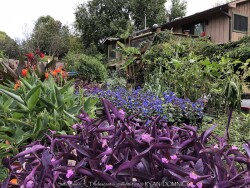

Purple Heart (Setcreasea / Tradescantia pallida 'Purple Heart') is the most versatile plant in out library: it can be an annual, perennial, patio plant, house plant, or hanging basket in wet or dry soil in full shade or full sun. It can handle growing in standing water or bone dry. In dry soils, it shows no drought stress, continuing to grow with a deeper purple shade. In moist soils, this plant will grow rapidly. In shade, the foliage becomes more greenish but still looks attractive. In Kansas, it is usually grown as an annual. Brilliant purple leaves contrast small pink flowers in the summer! Plants will quickly fill an annual bed with bright purple color all summer til first hard freeze. In the ground, it is possible to overwinter these in the ground in Kansas by placing a 6-8" mound of mulch over deeply planted rhizomes. Not sure what's easier, buying and moving that much mulch or replanting in spring?: you decide. If growing as a potted plant and trying to overwinter, allowing the foliage to frost is ok, it will not kill the root system. However, do not allow the pot with rootball to freeze solid or go below 20 degrees for more than a few hours. Allow to go dormant as needed with little care, just cut off dead foliage and place back out in April or May with a time-release fertilizer. Many plants will die back slowly and remain attractive inside for most of the winter. Purple heart plants have no insect, disease or animal pests. Botanical name has recently changed from Setcreasea to Tradescantia. A variegated form is also available. This plant survived in our Lawrence, KS display garden down to -16 degrees F and a week of single digit highs in February, 2021 with mulch.
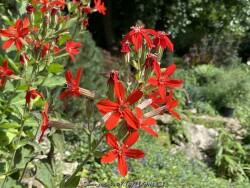

***Description for this perennial available with future update!***Scarlet Royal Catchfly / Silene, is also known as Silene regia
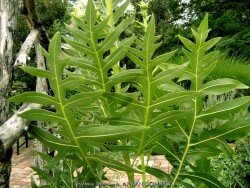

***Description for this perennial available with future update!*** Silphium laciniatum is also known as Compass Plant / Silphium >>>>>>>>>>>>Silphiums (Silphium laciniatum) are very long-lived perennials considered a "Once it's there, it's there forever" plant!
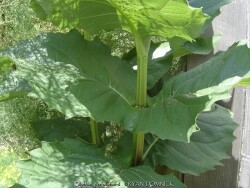

***Description for this perennial available with future update!*** Silphium perfoliatum is also known as Cup Plant / Silphium >>>>>>>>>>>>Silphium perfoliatum (Silphium perfoliatum) >>>>>>>>is also grown as a large bog plant needing constantly moist soil rich in organic matter. As a rain garden plant, it will thrive is a depressed area in the landscape that collects rain water from a roof during spring and summer periods of rain but then >>>>>might go partially dormant if the water hole dries out completely. Considered a "Once it's there, it's there forever" plant!
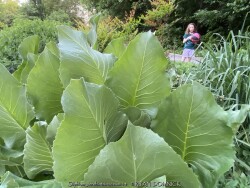

***Description for this perennial available with future update!*** Silphium terebinthinaceum is also known as Prairie Dock / Silphium >>>>>>>>>>>>Considered a "Once it's there, it's there forever" plant!
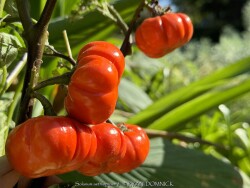

***Description for this plant available with future update!***Solanum aethiopicum is also known as Nakati / Pumpkin-on-a-Stick / Garden Eggs (Tropical)>>>>>> Easy to Eat Edible
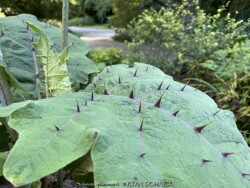

***Description for this plant available with future update!***Naranjilla / Bed of Nails (Tropical), is also known as Solanum quitoense. Easy to Eat Edible.


Bluestem Goldenrod (Solidago caesia) is a perennial wildflower with arching blue-green stems is native to the eastern and central parts of the United States and Canada. This woodland goldenrod occurs in open upland woods, shaded bluffs, slopes of wooded ravines and rocky cliffs. Yellow late-summer flowers contrast nicely with bluish purple stems. Considered one of the best plants for solving your most difficult dry-shade landscape challenges and still providing flowers if given at least a couple hours of sun or all-day dappled sun through the trees. Goldenrods are not wind-pollinated and therefore do not cause standard hay fever or allergies. This goldenrod attracts native bees, wasps and pollinating flies. Rabbit and deer resistance is good. This goldenrod has been planted in our trial gardens over 15 years ago on a dry-shade berm with 2-3 hrs of morning sun. The slowly expanding clump is virtually maintenance free, only needing trimmed in fate fall. This species does not spread by rhizomes or runners like some other goldenrods but will self-seed prolifically if you do not mulch. Bluestem Goldenrod is not well known or available in garden centers but worthy of wider scale landscape use.
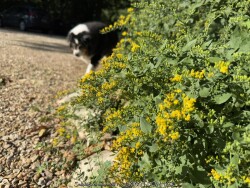

***Description for this perennial available with future update!*** Solidago drummondii is also known as Cliff Goldenrod.
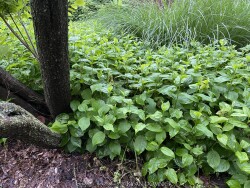

Zig Zag Goldenrod (Solidago flexicaulis) is native to the eastern and central parts of the United States and Canada. This woodland goldenrod, with erect, somewhat zig-zag stems, bears small flower heads at each node along the stem and upper leaves. The oval leaves are a rich green, pointed, and coarsely toothed. Considered one of the best plants for solving your most difficult dry-shade landscape challenges and still providing flowers. Goldenrods are not wind-pollinated and therefore do not cause standard hay fever or allergies. This goldenrod attracts butterflies. Rabbit and deer resistance is good. Zig Zag Goldenrod has been planted in our trial gardens over 10 years ago on a hill in part-sun to dry shade. The slowly expanding clump is virtually maintenance free, only needing trimmed in fate fall. Zig Zag Goldenrod is not well known or available in garden centers but worthy of wider scale landscape use.